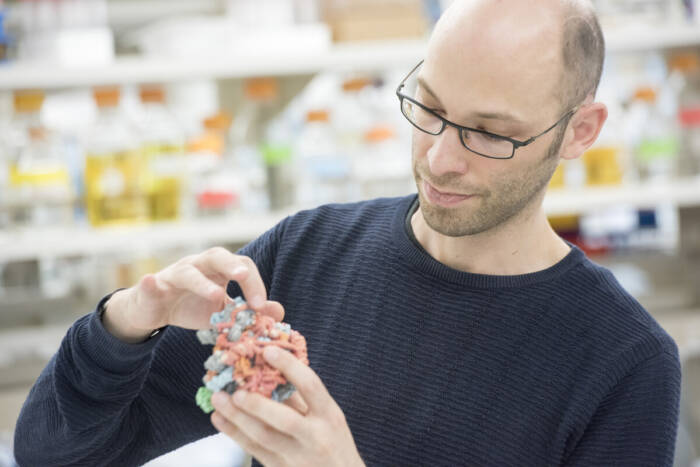Sequential immunizations could be the key to HIV vaccine
The secret to preventing HIV infection lies within the human immune system, but the more-than-25-year search has so far failed to yield a vaccine capable of training the body to neutralize the ever-changing virus. New research from The Rockefeller University, and collaborating institutions, suggests no single shot will ever do the trick. Instead, the scientists find, a sequence of immunizations might be the most promising route to an HIV vaccine.

Guiding antibody evolution: To explore the possibility of a sequence of immunizations to prevent HIV, researchers examined the immune response at different points to two antigens, or foreign proteins, designed to mimic the virus. Above, antibodies from mice immunized by one of these antigens are grouped by color.
Scientists have thought for some time that multiple immunizations, each tailored to specific stages of the immune response, could be used to generate a special class of HIV-fighting antibodies, so-called broadly neutralizing antibodies. The findings, published June 18 in Cell and the result of a collaborative effort by Rockefeller, The Scripps Research Institute, Weill Cornell Medical College, and other institutions, provide the first evidence supporting this approach.
“As HIV mutates in a patient, the immune system continually adapts. In some patients, this process produces broadly neutralizing antibodies, which are unusual antibodies that can bind to and neutralize a wide range of globally occurring HIV variants. These are the antibodies we want to try to elicit with a vaccine,” says co-first author Pia Dosenovic, a postdoctoral fellow in Michel Nussenzweig’s Laboratory of Molecular Immunology at Rockefeller.
“Our experiments suggest that by stimulating the immune response with tailored immunizations at specific stages, it may be possible to successfully mimic this process,” says co-first author Lotta von Boehmer, an instructor in clinical investigation also in Nussenzweig’s lab.
HIV is a pernicious virus precisely because its continual mutations make it a difficult target for antibodies, immune proteins that recognize foreign molecules called antigens. But one part of the virus cannot mutate: the binding site on the spike protein with which the virus attacks immune cells known as CD4 T cells. This part of the virus can’t change because without it, HIV would not be able to attach to and infect the T cells. As a result, it is a key part of the antigen targeted by some broadly neutralizing antibodies, which overcome attempts by the virus to protect this vulnerable site.
A small number of HIV patients develop broadly neutralizing antibodies naturally, as a result of infection. Like all other antibodies, they are produced by a type of immune cell, known as a B cell, which undergoes rounds of mutations that refine its antibodies’ ability to precisely target a specific antigen. As compared with antibodies against other pathogens, such as flu, these broadly neutralizing antibodies are distinctive, in part because they have undergone a great deal of mutation. Researchers have been working to find a shortcut to the process, but so far these broadly neutralizing antibodies have proven difficult to elicit with a vaccine.
But where one vaccine has failed, perhaps two or more can succeed. The Rockefeller research team tested how two variations of the crucial HIV antigen affected the B cells’ response when administered either early in the progression of the immune system’s initial response to HIV, or later during the process. The work was conducted in mice genetically engineered to produce antibodies resembling those of humans.
One group of mice had antibodies with no HIV-targeting mutations; these represented a B cell response during the early stages of infection. The antibodies expressed by the other mice contained mutations associated with the development of broadly neutralizing antibodies, and so stood in for a later stage of infection.
For each scenario, they tested both types of antigens. The first, an antigen engineered to make the crucial CD4 binding site easily accessible, was made by William Schief and colleagues at Scripps. The second, designed by John Moore and Rogier Sanders at Weill Cornell, closely resembled the natural version found in HIV.
For the early-stage scenario, the engineered antigen showed promise by prompting the antibody-producing B cells to proliferate and produce antibodies with key traits representing a preliminary step toward the production of broadly neutralizing antibodies. Meanwhile, the more natural antigen was more effective later on, inciting the mice to produce antibodies capable of neutralizing a number of different HIV strains.
“The engineered antigen made it possible for the mice’s hybrid immune system to get the response started. However, the more natural antigen is better at fine tuning the antibodies,” von Boehmer says.
The implication is that by delivering specifically tailored antigens at specific times, the body’s natural immune response can be guided, stepwise, through the process of developing broadly neutralizing antibodies.
“While our results suggest sequential immunizations may make it possible to vaccinate against HIV, we have only just begun to understand how this sequence would work,” Dosenovic says. “We know the beginning and the end, but we don’t know what should happen in the middle.”
This research was led by Nussenzweig, Zanvil A. Cohn and Ralph M. Steinman Professor, a senior physician at The Rockefeller University Hospital and a Howard Hughes Medical Institute investigator, and Schief, a professor at The Scripps Research Institute and director, Vaccine Design of the International AIDS Vaccine Initiative Neutralizing Antibody Center at Scripps.
In two papers published June 18 in Science, the researchers who generated the antigens used in this study tested them individually for potential use in vaccines. With the engineered antigen made in Schief’s lab at Scripps, this team found they could induce the production of antibody “precursors” with some of the traits necessary to recognize and block HIV infection. Like the Cell paper, this study suggests the engineered antigen could be a good candidate as the first in a series of immunizations against HIV. Likewise, in a separate Science paper, Sanders, at Weill Cornell, and his colleagues describe using the native antigens to induce the production of antibodies against a single strain of the virus, an important first step toward a vaccine.
 |
Cell 161, 1505–1515 (online June 18, 2015) Allosteric Immunization for HIV-1 Broadly Neutralizing Antibodies in Human Ig Knockin Mice Pia Dosenovic, Lotta von Boehmer, Amelia Escolano, Joseph Jardine, Natalia T. Freund, Alexander D. Gitlin, Andrew T. McGuire, Daniel W. Kulp, Thiago Oliveira, Louise Scharf, John Pietzsch, Matthew D. Gray, Albert Cupo, Marit J. van Gils, Kai-Hui Yao, Cassie Liu, Anna Gazumyan, Michael S. Seaman, Pamela J. Bjorkman, Rogier W. Sanders, John P. Moore, Leonidas Stamatatos, William R. Schief, and Michel C. Nussenzweig |


